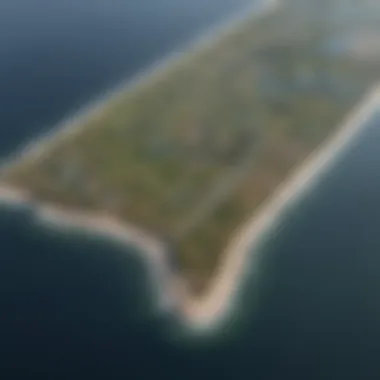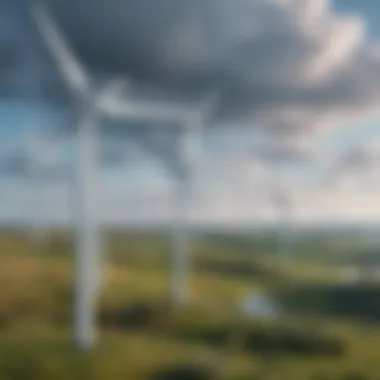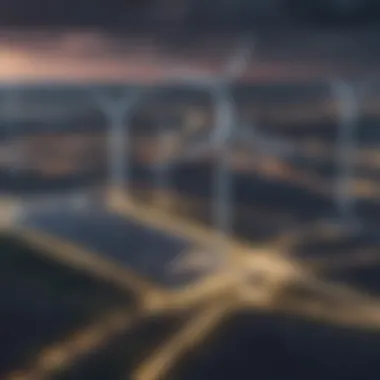The Evolution of Wind Energy Innovations in Denmark


Technology Insights
Denmark has emerged as a global leader in wind energy technology. Through pioneering research and development, the country has spearheaded innovative solutions for harnessing wind power efficiently. The latest tech trends in Denmark's wind energy sector focus on enhancing the performance and sustainability of wind turbines. Renewable energy experts in the country have been exploring cutting-edge innovations in tech to optimize the generation of electricity from wind resources. Product reviews of advanced wind turbines showcase the evolution of design and functionality, reflecting Denmark's commitment to pushing the boundaries of clean energy.
Industry Spotlights
In interviews with tech experts from Denmark's renewable energy industry, key insights emerge regarding the trajectory of wind energy in the country. These discussions shed light on the challenges and opportunities in scaling up wind power capacity and integrating it into the national grid effectively. Behind-the-scenes glimpses into the operations of wind energy companies provide a glimpse of the intricate planning and engineering involved in ensuring the success of wind projects. Designers to watch in the wind energy sector are highlighted for their contributions to creating visually appealing and efficient wind turbine solutions.
Introduction
Denmark has emerged as a frontrunner in the realm of wind energy, showcasing a remarkable commitment to sustainable solutions. As the world navigates environmental challenges, Denmark's proactive approach towards embracing wind power stands out. This article delves into the intricate details of Denmark's journey towards harnessing wind energy for a greener future.
Overview of Denmark's Commitment to Wind Energy
The Importance of Renewable Energy
Renewable energy stands as the cornerstone of Denmark's energy strategy. With a strong emphasis on sustainability, the country has prioritized renewable sources like wind power to reduce carbon footprint and combat climate change. Renewable energy plays a pivotal role in ensuring a clean and reliable energy supply while mitigating environmental harm. Denmark's steadfast commitment to renewable energy underscores a progressive vision towards a more sustainable future.
Denmark's Position in Wind Energy
Denmark's leadership in wind energy is unparalleled. The country's strategic investments and groundbreaking innovations have positioned it as a global powerhouse in the wind energy sector. With a conducive environment for wind energy projects and a strong foundation in technological expertise, Denmark has established itself as a hub for wind energy research and development. The integration of wind power into the national energy grid has not only reduced reliance on fossil fuels but has also set a precedent for other nations looking to transition towards sustainable energy sources. Denmark's prominent role in wind energy exemplifies a harmonious blend of environmental consciousness and technological advancement.
Pioneering Offshore Wind Farms


Introduction to Offshore Wind Farms in Denmark
Anholt Offshore Wind Farm
The Anholt Offshore Wind Farm stands out as a prominent example within Denmark's offshore wind energy landscape. This particular installation showcases the optimal utilization of offshore wind resources, highlighting the nation's strategic positioning in harnessing renewable energy sources. The key characteristic of the Anholt Offshore Wind Farm lies in its capacity to generate substantial electricity through offshore wind turbines, contributing significantly to Denmark's renewable energy goals. One unique feature of the Anholt Offshore Wind Farm is its location, which capitalizes on strong maritime winds for enhanced energy production. While the farm boasts remarkable advantages in bolstering Denmark's sustainability endeavors, challenges such as maintenance costs and environmental impacts require careful consideration in the ongoing discourse surrounding offshore wind energy.
Horns Rev
Horns Rev 3 emerges as another pivotal player in Denmark's offshore wind energy narrative. This offshore wind farm exemplifies technological innovations that drive advancements in harnessing wind power for electricity generation. The distinctive characteristic of Horns Rev 3 lies in its expansive scale, reflecting Denmark's ambitious undertakings in promoting renewable energy sources. The utilization of cutting-edge technologies within Horns Rev 3 positions it as a leading choice in the country's endeavor to establish sustainable energy solutions. A unique feature of Horns Rev 3 is its integration of efficient turbine designs that maximize energy output while minimizing environmental footprint. Despite its notable advantages in bolstering Denmark's renewable energy portfolio, challenges related to grid integration and intermittency issues underscore the complexities involved in scaling up offshore wind energy projects.
Government Initiatives and Policies
In the realm of wind energy in Denmark, Government Initiatives and Policies play a crucial role in fostering the growth and sustainability of the renewable energy sector. Denmark's commitment to renewable energy is evident through its various policies that support and incentivize the development of wind projects. These initiatives aim to reduce carbon emissions, enhance energy security, and propel the transition towards a greener future. By prioritizing renewable energy sources like wind power, Denmark sets a precedent for other nations to emulate.
Feed-In Tariffs and Subsidies
Investments in Renewable Energy
Investments in Renewable Energy are pivotal for driving the expansion of wind energy in Denmark. The government's financial incentives and subsidies promote private and public investments in renewable projects, including wind farms. These investments not only foster technological advancements but also bolster the country's energy independence and reduce reliance on fossil fuels. With a focus on renewable energy, Denmark secures its position as a global leader in sustainable practices.
Support for Wind Energy Projects
Support for Wind Energy Projects is integral to the success of Denmark's renewable energy transition. Government support, through grants, tax incentives, and regulatory frameworks, facilitates the deployment of wind power infrastructure. This backing encourages innovation in wind technology, improves project feasibility, and increases market competitiveness. By championing wind energy projects, Denmark showcases its dedication to achieving energy sustainability and combating climate change effectively.


Technological Advancements in Wind Energy
Denmark's position as a leader in wind energy is significantly attributed to continuous advancements in technology. These innovations play a pivotal role in enhancing the efficiency and sustainability of wind power generation. By focusing on technological advancements, Denmark aims to stay at the forefront of renewable energy solutions, setting a benchmark for other nations to follow in the transition towards a greener future.
Innovations in Wind Turbine Technology
Efficiency Improvements
Efficiency improvements in wind turbine technology are crucial for maximizing energy output while minimizing operational costs. The key characteristic of these advancements lies in optimizing the conversion of wind energy into usable electricity, leading to higher output levels with reduced environmental impact. Efficiency improvements are essential not only for boosting energy production but also for ensuring the long-term viability of wind power as a sustainable energy source. Despite some challenges, such as intermittent wind conditions, efficiency improvements continue to evolve, making them a popular choice among renewable energy developers in Denmark.
Floating Wind Turbines
The development of floating wind turbines represents a significant breakthrough in offshore wind energy utilization. One key characteristic of floating wind turbines is their ability to operate in deeper waters, where traditional fixed-bottom turbines are not feasible. This feature makes floating wind turbines a beneficial choice for countries like Denmark, with vast offshore wind energy potential. Additionally, the unique aspect of floating wind turbines lies in their adaptability to various marine environments, offering advantages in terms of installation flexibility and scalability. While challenges such as maintenance costs may arise, floating wind turbines demonstrate great promise in expanding Denmark's offshore wind capacity and driving further technological advancements in the wind energy sector.
Environmental Impact and Sustainability
Denmark's commitment to wind energy not only showcases its technological advancements but also emphasizes its dedication to environmental impact and sustainability. The country's progressive approach towards renewable energy sources like wind power is a crucial step in combating climate change and reducing carbon footprint worldwide. By prioritizing sustainability in energy production, Denmark sets a precedent for other nations to follow in embracing eco-friendly solutions for a cleaner future.
Reducing Carbon Footprint
Wind energy plays a pivotal role in reducing the carbon footprint, mainly through minimizing greenhouse gas emissions. The utilization of wind power significantly decreases reliance on fossil fuels, thereby cutting down harmful emissions that contribute to global warming. Greenhouse gas emissions, such as carbon dioxide and methane, are effectively reduced through wind energy generation, leading to a significant reduction in environmental pollutants and promoting a greener environment.
Greenhouse Gas Emissions


Greenhouse gas emissions are a focal point in environmental discussions, particularly due to their adverse impact on the planet. Wind energy stands out as a clean alternative to traditional sources like coal and oil, as it produces minimal greenhouse gases during electricity generation. This attribute of wind power aligns with sustainability goals, making it a popular choice for eco-conscious individuals and environmentally-responsible industries. The unique feature of wind energy lies in its ability to mitigate climate change by offering a low-carbon energy option while reducing greenhouse gas emissions that exacerbate the global environmental crisis.
Role in Climate Change Mitigation
The role of wind energy in climate change mitigation is fundamental to addressing the escalating environmental concerns. By harnessing the power of wind, countries like Denmark can reduce reliance on fossil fuels and transition towards cleaner energy sources to mitigate climate change. Wind turbines play a crucial role in offsetting carbon emissions, thus contributing significantly to global efforts to combat climate change. Denmark's emphasis on wind energy as a key player in climate change mitigation exemplifies its commitment to sustainability and environmental stewardship.
Challenges and Future Prospects
In the context of the in-depth exploration of wind energy in Denmark, the section on Challenges and Future Prospects plays a pivotal role. It delves into the crucial aspects that shape the trajectory of wind energy development in the country. One key element that dominates discussions within this realm is the efficient grid integration and storage of the generated wind power. Achieving seamless integration of renewable energy sources into the existing grid infrastructure is vital for ensuring a stable and reliable power supply. Moreover, the focus on storage solutions becomes increasingly important to address the intermittency of wind power generation. By maximizing grid integration efficiency and implementing advanced storage technologies, Denmark can further solidify its position as a leader in the wind energy sector.
Grid Integration and Storage
Intermittency Issues
The intermittent nature of wind power poses a significant challenge in ensuring a consistent energy supply. Intermittency issues refer to the fluctuations in energy production caused by the variability of wind speeds. This unpredictability can lead to challenges in balancing supply and demand on the grid, requiring innovative solutions for effective integration. Despite these challenges, leveraging advanced forecasting techniques and smart grid technologies can mitigate the impact of intermittency issues. By enhancing grid flexibility and adopting storage systems, Denmark can optimize the utilization of wind energy and minimize disruptions in power delivery, contributing to a more sustainable energy landscape.
Battery Technology
Battery technology plays a crucial role in addressing the storage requirements associated with renewable energy sources like wind power. The key characteristic of battery technology lies in its ability to store excess energy during periods of high generation and discharge it when needed, effectively bridging the gap between supply and demand. This technology offers a viable solution to store energy efficiently, enabling better grid management and reducing reliance on fossil fuel-based backup power sources. Despite the potential benefits, challenges such as high initial costs and limited storage capacity remain areas of consideration. Integrating battery technology into the energy infrastructure can enhance grid resilience, promote greater energy independence, and drive the transition towards a more sustainable energy paradigm in Denmark.
Conclusion
Denmark's Continued Leadership in Wind Energy
Sustainability Goals
Delveing into Denmark's sustainability goals reveals a multifaceted approach towards achieving environmental resilience and energy efficiency. The emphasis placed on sustainability goals within the realm of wind energy underscores Denmark's unwavering commitment to fostering eco-friendly practices and mitigating the impacts of climate change. By setting rigorous targets and standards for the integration of wind energy into its power grid, Denmark epitomizes a forward-thinking nation dedicated to ensuring a cleaner and greener future. The steadfast adherence to sustainability goals not only showcases Denmark's leadership in renewable energy but also cements its reputation as a pioneer in environmental stewardship.
Global Impact
Reflecting on the global impact of Denmark's wind energy advancements unveils a ripple effect felt across continents. The key characteristic of Denmark's global impact lies in its role as a catalyst for international collaboration and knowledge sharing in the renewable energy sector. By spearheading innovative approaches to wind energy and sustainability, Denmark has positioned itself as a thought leader, influencing global policies and initiatives. The unique feature of Denmark's global impact lies in its ability to inspire other nations to emulate its success in harnessing wind power for a sustainable future. While there may be challenges ahead, Denmark's global impact in the realm of wind energy stands as a testament to the transformative power of green technology in mitigating climate change and promoting environmental sustainability.







